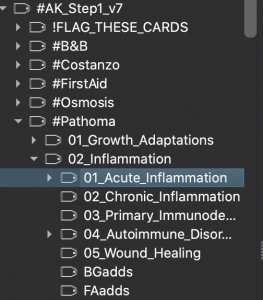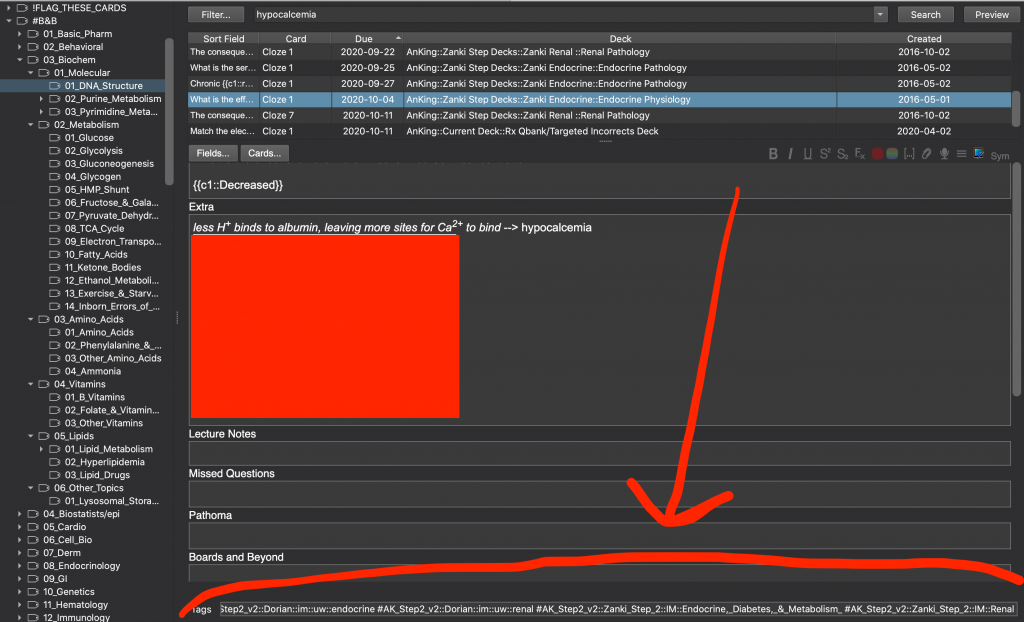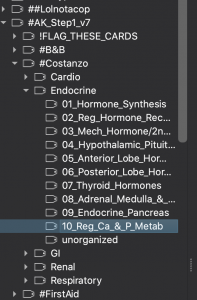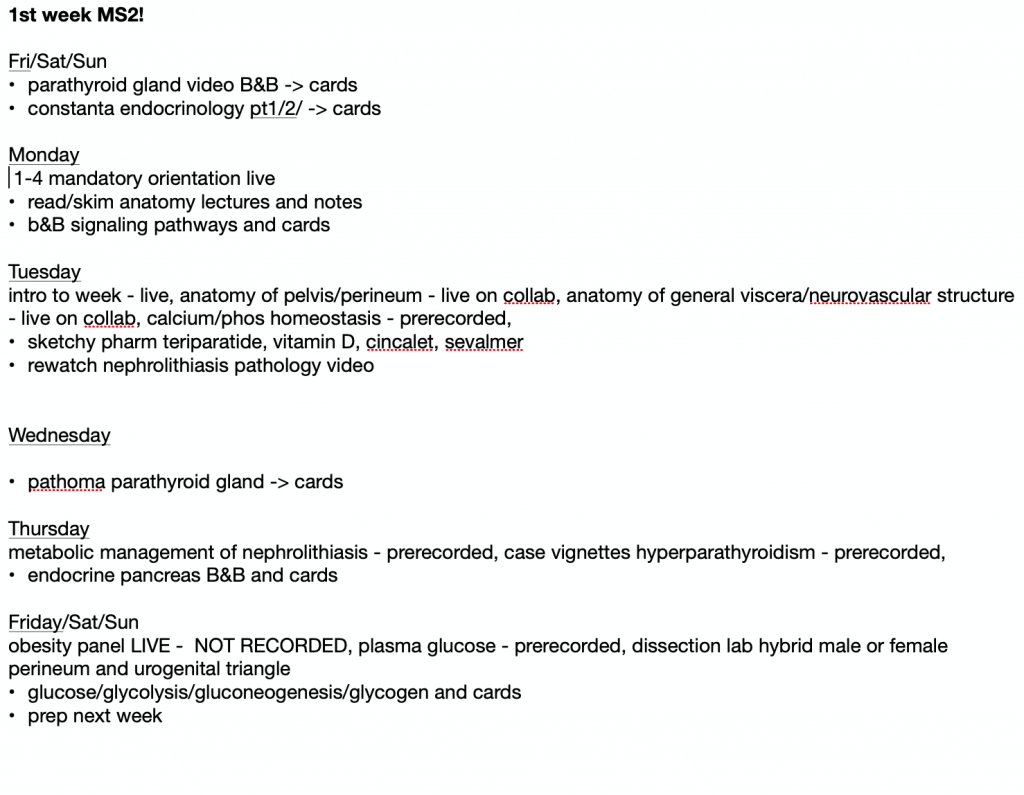How to use AnKing with Lectures – Medical School5 min read
So you know you need to use the AnKing deck, but how do you use it alongside lectures? How do you know which cards to unsuspend? Do you have to manually search for every card?
No.
Here is how to use AnKing with lectures in medical school.
Step 1: Identify what content you will be learning in lectures
What lectures do you have that week? Do you have any anatomy lectures? Histology lectures? Are you learning about pathology?
Write out every day what you are learning.
Then I plan that the day before I will learn and get a basic understanding of the material; preview the material. I preview the material with Anki, third-party resources, and finally a quick skim of the lecture.
Then, when I watch the lecture or attend the lecture, I have a basic understanding of the content. This understanding allows me to get much more out of the lecture than I would if I went in blind.
Step 2: Find that content in a Third-Party Resource, and, therefore, AnKing
How do you know which cards to unsuspend? Well, there are two ways that I find the right cards to study:
Card-finding option A
The title of the lecture is directly matched up to a B&B video, pathoma video, sketchy video, or youtube video. This is easy mode. Oh, the lecture is on acute inflammation? Pathoma ch 2.1, watch the video, unsuspend the cards, learn the cards, preview the lecture, done.

Card-finding option B
The lecture title doesn’t seem to match up anywhere. You have to dig a little deeper. Look at the lecture slides, what is the main point? Are there certain terms you can identify?
- Then go to “browse” in Anki. Search for that term, can you find some cards that seem relevant to that lecture?
- NO, you won’t have to search for every card.
- Take a look down, all the way towards the bottom of the screen, you should see something called “tags” (picture below)


- Look above! See? This is just one of the tags but there is a B&B video tagged to this card, if you keep scrolling you would see BRS physiology chapter tagged to this and a first aid chapter tagged to this card!
- Next, you want to go that video in Anki and see if all the cards are relevant. Maybe the B&B video is too unrelated, but the first aid chapter is exactly what you need. So you pick one of those sections, learn that content, then unsuspend the cards tagged to the most relevant third party “section” you found.
- I found that the cards in Costanzo, Endocrine section 10, was the most relevant.
- So I would read that part of the chapter, unsuspend those cards, then study them!

A little more tricky, but as you practice finding the relevant cards you get better at it. The AnKing has everything you need.
Step 3: Study that content
Watch the video, make sure you understand what is going on.
Then unsuspend the relevant cards, but wait!
Before you begin smashing the spacebar look over each card in the browse section. Read the related first aid material, read the “additional resources.”
Develop an Understanding. Understanding > Memorization.
Step 4: Preview the lecture
Take a look at the lectures slides you will be presented tomorrow. Look over them briefly and quickly. Don’t take any notes. Imagine you were looking through a magazine.
I don’t look through any magazine longer than 15 minutes. So my preview never takes more than 15 minutes, and I never take notes on a magazine…
Then you’re done! Sleep, chill, let that information set into your brain overnight.
My Example Week:
Here is what my first week plan looks like for my first week of MS2. No it’s not pretty, it doesn’t need to be. I make this every Friday because that’s when my school releases next weeks lecture.
Some small things I do:
- Do all this Anki learning the day before I watch the lecture.
- Prioritize Anki and third party resources every day, so my studying for the day might look like (look at Tuesday)
- Do all my Anki reviews
- Watch relevant third-party resources for the next day’s lecture material. So that’s the sketchy pharm video.
- Unsuspend and study the correlated Anki cards. So that’s the sketchy pharm Anki cards.
- Watch the lectures of today. So that’s two anatomy lectures and a calcium and phosphate homeostasis lecture.
- The next day I don’t have any lectures, so I won’t preview lectures, but this would be my last part of the day.

I started making this weekly plan about halfway throughout my first year of medical school. I think it improved my score, I know it improved my stress levels and anxiety.
Now I know what I’m studying every day, so I just wake up and get to it.
-Zach
10 Comments
Tyler · June 21, 2021 at 10:19 pm
Hey Zach! I will be an incoming MS1 in the fall. I’ve been watching your videos since last year, and they helped me boost my MCAT score from the 80th to 96th percentile!
With classes starting soon, I’ve also watched nearly all of your medical school vlogs, and I feel much more confident having reviewed your strategies beforehand.
I do have one question for you. When it came time for Step 1, had you already reviewed all of the AnKing’s Step 1 deck just by working through it during the school year? Or, did you need to begin un-suspending cards outside of your school’s curriculum?
Seriously, thank you for producing this content and best of luck in clinicals!
Zach · June 18, 2022 at 5:16 pm
Awesome, and thank you! At the end of every major “block” I would unsuspend all the cards that were left in the AnKing deck. So, for example, if there were 400 cards left under “Cardiology” and I had already finished that section in medical school, I would unsuspend that at the end of my block. So, by the time step 1 came around, I had reviewed pretty much everything. I would go to the browse section about two months before your dedicated period and search “is:suspended” then you can see what cards you still have left and start working through them before dedicated. I go through all the step 1 material before my dedicated period.
Lakshya · February 15, 2022 at 8:32 pm
Hi Zach
I want to ask that how to do the overlapping cards?
For example if am studying physiology then from where to unsuspend it either from board and beyond or BRS physiology
Zach · February 27, 2022 at 10:00 pm
Lakshya, it doesn’t matter which you unsuspend it from. Those are both one card with multiple tags.
Sketchy Team · April 9, 2022 at 12:44 am
We’ve been partnering with the creators of the AnKing deck to get fully updated references to our Sketchy Medical lessons with direct links to our lessons. This will make it easier and more effective to combine AnKing deck and Sketchy!
Zach · June 18, 2022 at 7:45 pm
Woah, are you the real sketchy team? Want to work together?
Blake · July 28, 2022 at 11:26 pm
Let’s say the lectures you plan to watch tomorrow have related third-party videos from both B&B and Sketchy. Would you watch ALL the third-party videos, or would you pick only the B&B OR Sketchy videos? Thanks!
Zach · August 17, 2022 at 1:34 pm
I would max out at ~100 new cards on Anki. So I would look in my deck for both of those specific videos and how many cards are related to them and do both if they are under 100 cards on Anki, otherwise I would do only one. I would probably do B&B first because that focuses more on general ideas as opposed to specifics like with Sketchy. The next day I would do sketchy.
hanan · May 26, 2023 at 11:03 pm
hi i am in my first year at medscool and our exam is mcq form but i find it difficult to study for mcq cuz i memoriz every topic but the mcq seem different can u tall me how to study the slide info in mcq way ,i dont know if u understand me but i am asking that should i know every detail in lecture slide i see student tell me that focus on enzyme name in bio for example ,like how did they know what to focus on in lecture ,another example that in histo if there in anatomy info in it the student skipped that like why they skip it it on the slide ,how i would know that pls answer me doctor
Zach · June 4, 2023 at 7:51 pm
First I would talk to an advisor and ask for help. Otherwise, however, I would emphasize understanding over memorization. You should only be using Anki after you have a basic understanding of the topic. I have a good video on using Anki here: https://www.youtube.com/watch?v=96VbRWUPAA0&t=6s